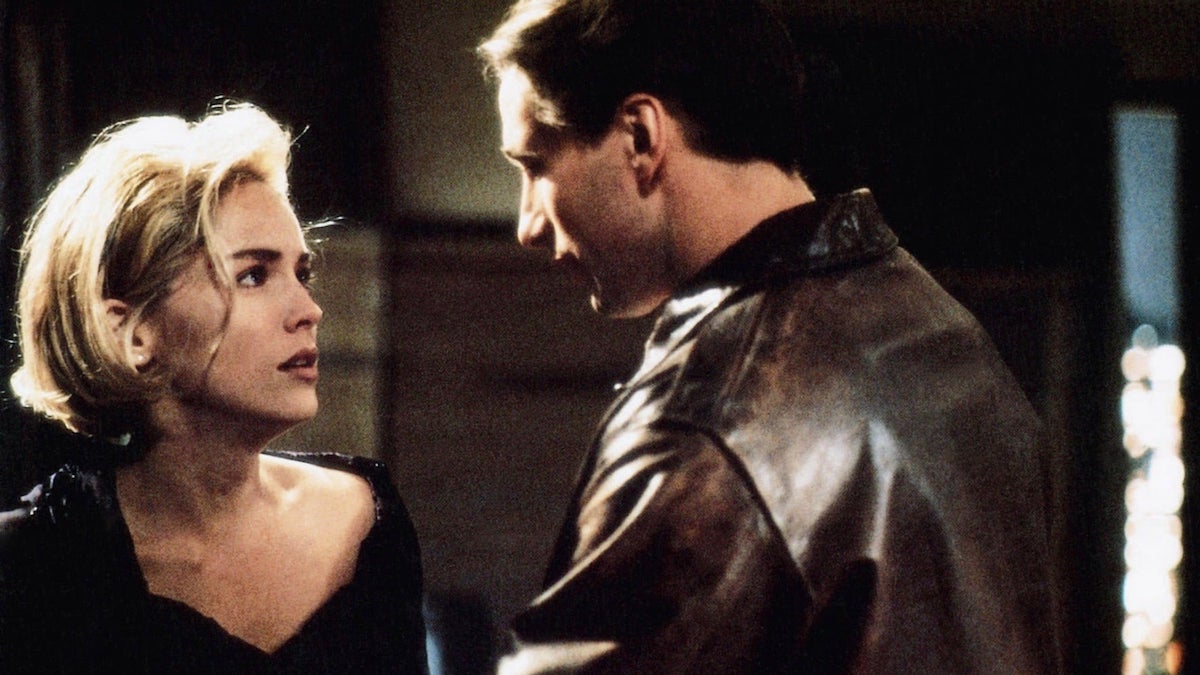SLIVER (1993)
A woman moves into a New York apartment building beset by suspicious deaths.

A woman moves into a New York apartment building beset by suspicious deaths.


Here’s the honest truth: when I volunteered to write a retrospective on Sliver, I’d forgotten what a calamitous film it is. I recalled it as slick, smart, and paranoid… but, in reality, while some aspects of it (e.g. Howard Shore’s forgettable score) are just common-or-garden mediocre, others are laughably clunky or plain nonsensical.
This is a surprise, given its pedigree. Screenwriter Joe Eszterhas had penned the fine thriller Jagged Edge (1985) before scoring a huge hit with Basic Instinct (1992), a film which Sliver blatantly attempts to emulate. Director Phillip Noyce had proved in Dead Calm (1989) he could direct a small cast in limited locations (three people, two boats) in a clear, precise style with great tension; subtlety wasn’t its strong point but it boded well for the similar setup of Sliver. After his recent move to the US, Noyce had also shown a talent for audience-pleasing on a bigger budget with Patriot Games (1992), and he would later make other films far superior to Sliver, too—Rabbit-Proof Fence (2002) and The Quiet American (2002).

The novel by Ira Levin, meanwhile, was a typically clever, suspenseful exercise from a much-filmed author (A Kiss Before Dying, Rosemary’s Baby, The Stepford Wives, The Boys From Brazil) who, like a less portentous Michael Crichton, always managed to introduce interesting ideas into his work without letting them overwhelm the narrative. His novels are inherently far-fetched, but effective pacing and credible, if not very deep characterisations, help make them real to the reader.
Levin’s Sliver did end with an incredible attack on the baddie by the heroine’s pet cat, but it was a minor misjudgement. That feline didn’t make it into Eszterhas’s screenplay, fortunately, but on a bigger scale, it’s an object lesson in how not to adapt a novel for the screen. Notably, the relationship between the two main characters–renamed Carly (Sharon Stone) and Zeke (William Baldwin) for the film—is a major strength of Levin’s book. In particular, he gives his female protagonist enough doubts about falling in love that it didn’t come over as implausibly abrupt.

Eszterhas fails to do this and he also manages to make Carly, whose potential peril is the core of the story, a weak character it’s difficult to relate to. As written by Eszterhas, she’s largely passive–in one of the movie’s major showdown scenes she essentially does nothing but watch two men fight—and she seems to change her mind too easily without a good explanation. For example, being angry with Jack (Tom Berenger) and then taking his side, or being horrified at Zeke’s voyeurism and then accepting it.
Instead of delivering an engaging character and an intriguing story, Eszterhas and Noyce appeared to be banking on the erotic appeal promised by the mere presence of Stone so soon after Basic Instinct; a scene where Carly shows Zeke her underwear at a restaurant table is a rework of that film’s most infamous moment. (The underwear, like Carly’s hair, the metallic interiors of her apartment building’s elevators, and pretty much everything else, has that shiny late-1980s/early-1990s feel later mocked in 2000’s American Psycho.)
But again Sliver doesn’t quite hit the mark; it was cut extensively to avoid an NC-17 (over-17s only) certificate in the US, and while there’s plenty of nudity and some rather tedious sex… for the most part, it merely gets in the way of the plot rather than adding any frisson.

Carly, a recently divorced editor for a publishing house, moves into a Manhattan “sliver” building—one of the very narrow skyscrapers that were then a new phenomenon—sinisterly named “113” after its street address, where she discovers the previous inhabitant of her apartment committed suicide. (The real building was Morgan Court, at 211 Madison Avenue.) It should be an additional red flag to her that Zeke lives on the 13th floor, but she’s soon conducting a passionate affair with the younger man.
Meanwhile, she also makes the acquaintance of other neighbours including Gus (Keene Curtis), Vida (Polly Walker), and the overly self-assured novelist Jack, who warns her about Zeke. Further deaths occur in the building, which becomes dubbed the “Horror High-Rise”, and another mystery is apparent to the audience—though not Carly—from the very beginning: someone is spying on the building’s residents through hidden cameras and a vast bank of screens. Indeed, paying close attention to the title sequence reveals exactly where the cameras are located.
The fact Carly is oblivious to this while the audience knows it is going on, even if we don’t know who’s doing it, does help to build tension and allows Sliver to at least start exploring ideas around privacy and its invasion. For example, when Carly hosts a party in her apartment, everyone wants to try out her telescope to spy on the building opposite—even Jack, who claims to disapprove. But ‘the watchers’ then become ‘the watched’ once the couple they’ve been peeking at turn out to have their own telescope.

So the makings of a creepy, uncomfortable thriller of modern urban life are certainly there. But there are grave problems with the writing and the departures from Levin, or at least the failure to change his tight plotting into something equally satisfying. For example, one of the murders has a rational motive in the novel, but it’s not made adequately clear in the film, and a point about some of the victims resembling Zeke’s mother turns out to go nowhere.
Most importantly, the ending was changed at the last minute after poor test screenings—Eszterhas rapidly wrote eight new alternatives, and Christopher Young composed new music. While the original conclusion was rather OTT in itself (a brief earlier reference to a volcano is the only trace of it that survives in the released movie), the version eventually used isn’t so much a twist as a damp squib, robbing the Carly-Zeke relationship and indeed the hidden cameras of any real significance.

Sliver did reasonably well at the box office, doubtless thanks to the Basic Instinct effect, but didn’t meet with much acclaim at the time. One unnamed Variety critic called it “a cold, inaccessible yarn about murder and voyeurism that’s too leisurely about getting where it needs to go and doesn’t fully develop what should be its core”, singling out sex scenes that “aren’t all that steamy” and “highrise-size lapses in logic”. Chris Hicks in Deseret News mused that “Agatha Christie and Alfred Hitchcock must be spinning in their graves.”
Performances weren’t praised, either, although both Stone and Baldwin do try to make the best of their thinly-written characters; Stone’s Carly knowing she ought to be cautious but unable to resist her own less wise impulses, Baldwin’s Zeke becoming more interesting once you start to suspect that his niceness is concealing something else.
Berenger’s Jack is misjudged, though; Levin’s roughly equivalent character is every bit as pleasant as Zeke, albeit in a different way, and this works much more convincingly than the unlikeable Jack we get from Berenger. He’s supposedly an investigative journalist but more self-absorbed than any I have known—the ability to listen is an important part of the job, after all…

Sliver is bad and sometimes dull, but it can at moments be interesting as a reflection of its times. E-mail makes a relatively early Hollywood appearance, for instance, and the central concept of the film was prescient—awareness of ubiquitous surveillance had not yet become commonplace, and nor for that matter had reality TV. (On the screens in 113, though, everyone is doing “interesting” things all the time, like a child’s idea of grown-up life.) Voyeuristic pornography, too, is suggested by some of the material seen on the screens, such as Carly in her bathtub.
It fits naturally into the surprisingly large category of disturbing-apartment-building movies: to name just a few examples, David Cronenberg’s Shivers (1975), the Nazi torture/slasher Crawlspace (1986), more recently Ben Wheatley’s High-Rise (2015), and of course the adaptation of Rosemary’s Baby (1968). Indeed, Levin had wanted that film’s director, Roman Polanski, to make Sliver.

It also has obvious points in common with films like Rear Window (1954) and the more recent Watcher (2022), in which spying on and from apartments is fundamental, as well as movies about surveillance like Brazil (1985), The End of Violence (1997), The Truman Show (1998), and innumerable examples from more recent years. And, made at a time when New York City was trying to overcome its reputation for street violence, Sliver should gain resonance from the suggestion that danger could also be present in the safe space of the home, as did Panic Room (2002).
Given how effectively so many of these films exploited the ideas that Sliver touches on, how could it fail given so much strong material to work with? The answer lies in execution, and specifically in the script.
Sliver assembles all these elements, implicit in Levin’s novel as well as in other films, but then does very little with them. It gives the impression of a murder mystery, with sex scenes and a meditation on surveillance culture rammed together, all of them rather half-hearted and none of them fit with the others. Ultimately, the glimpses of people going about their lives on the surveillance screens in 113 are more compelling than the movie itself.
USA | 1993 | 107 MINUTES | 1.78:1 • 2.39:1 | COLOUR | ENGLISH


director: Phillip Noyce.
writer: Joe Eszterhas (based on the novel by Ira Levin).
starring: Sharon Stone, William Baldwin & Tom Berenger.
